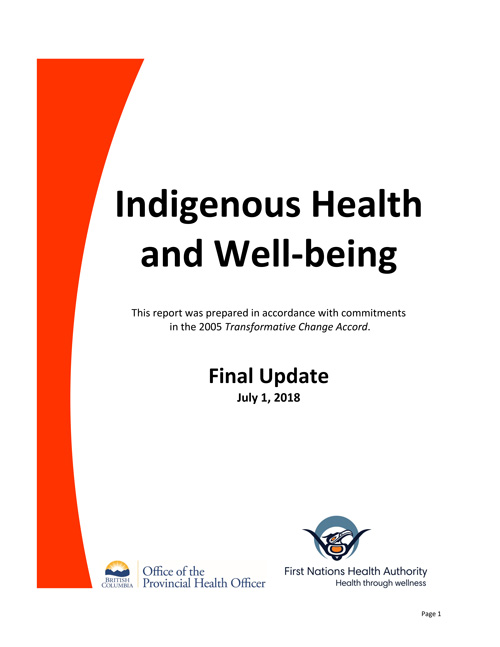For Immediate Release


Coast Salish Territory (Vancouver, B.C.)
A 10-year undertaking to track Indigenous health in B.C. has found improvements in five key areas, however the gap between the health status of Indigenous and non-Indigenous residents continued to widen in three of those areas.
A report released today by the First Nations Health Authority (FNHA) and the Office of the Provincial Health Officer (PHO) summarizes the results of tracking life expectancy, mortality, youth suicide, infant mortality, and diabetes rates between 2005 and 2015.
Key findings include:
• Life expectancy among Status First Nations people improved between 2005 and 2015 but the life expectancy for other residents of B.C. improved at a faster rate, so the health status gap actually widened.
• The age-standardized mortality rate (ASMR), which measures death from all causes, improved somewhat since 2005, but the health status gap increased.
• The youth suicide rate decreased and although the gap with other B.C. residents did not quite meet the targeted 50 per cent reduction it did decline substantially (by 38%).
• The infant mortality rate decreased slightly since 2005 but the gap between the population groups increased.
• The diabetes prevalence rate continued to increase for both population groups but the rate of increase for First Nations people declined, resulting in an overall decrease in the health status gap that exceeded the 33 per cent reduction target.
"Tracking supports acting," said Dr. Evan Adams, Chief Medical Officer of the FNHA. "We have hard-wired our First Nations health objectives into the provincial health system and are well-positioned to understand progress and challenges in health outcomes for Indigenous people in B.C. and to work together to eliminate health inequities."
The Transformative Change Accord: First Nations Health Plan committed First Nations leadership and the Governments of British Columbia and Canada to achieve specific health targets by 2015 on seven core health indicators (see attached backgrounder for more information). The PHO and FNHA have agreed to continue to jointly monitor the health and well-being of First Nations people in B.C. for the next 10 years with an expanded suite of 22 indicators of health and well-being, called the Indigenous Population Health and Wellness Agenda.
"We've achieved meaningful progress in several areas of Indigenous health, as well as in the way that we work with our Indigenous partners," said Provincial Health Officer Dr. Bonnie Henry. "I'm particularly excited that the next phase of this project includes an expanded suite of indicators that incorporates a First Nations perspective and a focus on wellness and strengths."
"We have entered a new era of collaborative Indigenous health reporting between BC's Office of the Provincial Health Officer and FNHA's Office of the Chief Medical Officer, and we are focused on using a strengths-based approach that reflects many root causes of Indigenous peoples' health and wellness," said B.C.'s Indigenous Health Physician Advisor, Dr. Danièle Behn-Smith. "Also, for the first time, we are integrating the idea of two-eyed seeing into the report, by incorporating the strengths of both Indigenous ways of knowing and Western knowledge into our work."
The 22 health and wellness indicators that will be tracked and reported on regularly over the next decade include measures developed in consultation with First Nations communities. Examples include cultural wellness, community strength and resilience, and ecological health. Cultural wellness, for example, will be a combined indicator reporting on traditional language, traditional foods, traditional medicine/healing, and a sense of belonging to one's First Nations community.
"It's important that we change the way we describe our communities," said Dr. Adams. "We want to report on things that are important to our First Nations people. Those include measures that move us from a sickness to a wellness perspective, from weaknesses to strengths. This new focus will help guide our actions, leading us to a more proactive, holistic and culturally sensitive orientation – one that goes beyond the boundaries of our current health system."
The baseline report for the Indigenous Population Health and Wellness Agenda will be released in 2019.
Read the full 2018 Report on Indigenous Health and Well-being:
2018 Report on Indigenous Health and Well-being (PDF 2.68 MB)
Indigenous Health and Well-being, 2018 Report – Background Information
- The 2018 Indigenous Health and Wellbeing Report is a report on the first 10 years of indicators set out in the Transformative Change Accord: First Nations Health Plan for the monitoring period 2005-2015.
- The seven core indicators identified included five for which data were available in 2005: life expectancy, mortality rate, youth suicide rate, infant mortality rate, and diabetes prevalence.
- The project also set goals for collecting data on childhood obesity and the number of practicing, certified First Nations health care professionals, as well as work done to increase the number of professionals. In 2005 these subjects were not routinely measured. Since then, data collection mechanisms have been set up for these two indicators and an update on them is planned for the next reporting period.
Meanwhile, the FNHA has worked to increase the numbers of certified, practising First Nations health professionals with programs that include hiring goals, professional development opportunities, health care scholarships, and support for recruitment programs at regional health authorities.
Media Contacts:
John Moody, Media Relations
First Nations Health Authority
604-831-4898
john.moody@fnha.ca
Jessica Li, Media Contact, Office of the Provincial Health Officer
250-952-1887
Jessica.P.Li@gov.bc.ca
The First Nations Health Authority (FNHA) is the only First Nations province-wide health authority in Canada. It is responsible for planning, management, service delivery and funding of health programs, mostly focused on health promotion and disease prevention. Guided by the vision of embedding cultural safety and humility into health service delivery, the FNHA works to reform the way health care is delivered to B.C. First Nations people through direct services, provincial partnership collaboration, and health systems innovation. For more information about the First Nations Health Authority, visit www.fnha.ca.
Download a PDF of this Media Release here. (PDF 179 KB)

